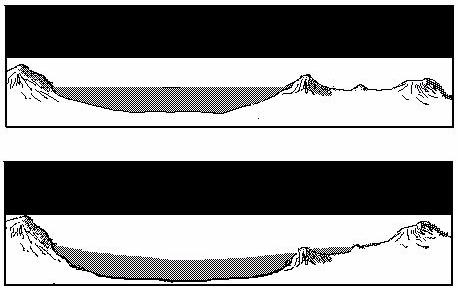Observing the Moon: Sagging Craters
Jack Kramer
On the edges of some lunar maria are craters that are partially filled with the darker regolith (lunar "soil") from the maria. It appears that when the hot magma welled up to fill the space of the maria, it also overspilled the walls of nearby craters. In fact, this is what has actually happened in many cases.
But there is also a line of thought that in certain instances, the various levels of molten maria material slumped as it cooled. That is, the mare has caved in somewhat. It is theorized that this slumping caused objects at the edges of the mare to tilt inward enough to allow some of the still molten magma at the edges to flow into the craters. The following cutaway illustrations show a crater to the right and first how it looks in a "level" state, then what might have happened as the floor of the mare slumped. The second drawing is greatly exaggerated for purposes of demonstration.

Mare Humorum is one of the sites where this could be a possibility. The rationale is that the heights of some crater walls are lower on the sides facing the interior of the mare. The walls gradually rise, reaching their highest points at the edges farthest from the mare. This is most dramatically shown in situations where craters are completely missing sections of their walls. But there is by no means universal agreement that this is the way it happened for all the craters. In the case of the large crater Gassendi, more recent high-resolution views from spacecraft show that the walls do not appear to have been breached, which suggests instead that the magma welled up inside Gassendi from fractures in the floor of this crater. In addition, there are many craters that lie at the edge of this and other mare, yet appear to be intact. In some cases, these may be the results of impacts that occurred after the Maria formed. Could some craters have tilted while others didn't, based perhaps on the condition of the underlying material?
Next time you observe the moon, it might be interesting to look for magma-filled craters that appear to have tilted inward. This possibility would be especially strong in cases where a crater is missing part of its wall but the darker mare material has not covered the entire floor of the crater. Watch for subtle differences in the brightness of the regolith within the craters. Also look for rills on the floors of the craters. This could indicate that at least some of the magma arose from directly beneath the craters.
In order to see details such as this, you'll need to observe on a night with very good seeing, using high magnification on a telescope with good resolution. Concentrate on areas near the terminator where crater walls stand out best and shadows indicate the condition of the walls facing the mare. Of course, images from spacecraft are the final word, often showing details that we could never glimpse from Earth.
Published in the April 2000 issue of the NightTimes




